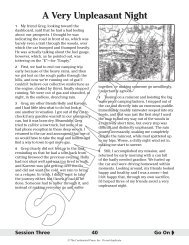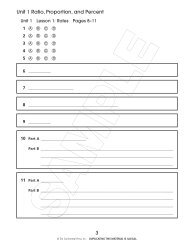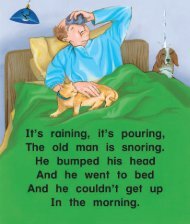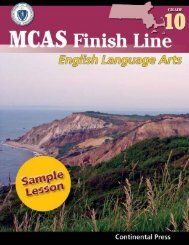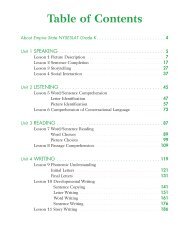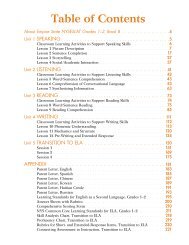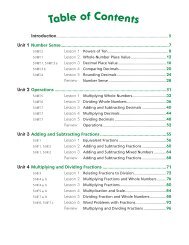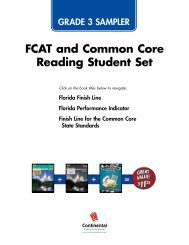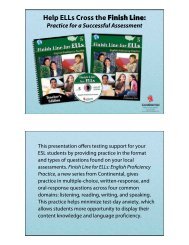Unit 2 Comprehension and Reading Skills 57 - Continental Press
Unit 2 Comprehension and Reading Skills 57 - Continental Press
Unit 2 Comprehension and Reading Skills 57 - Continental Press
You also want an ePaper? Increase the reach of your titles
YUMPU automatically turns print PDFs into web optimized ePapers that Google loves.
ContentsIntroduction to PSSA Finish Line <strong>Reading</strong> Grade 4. . . . . . . . . . . . . . . . . . . . . 4<strong>Unit</strong> 1: Vocabulary . . . . . . . . . . . . . . . . . . . . . . . . . . . . . . . . . . . . . . . . . . . . . . . . 5Lesson 1 Meaning of Vocabulary . . . . . . . . . . . . . . . . . . . . . . . . . . . . . . . . . . . . . 6Lesson 2 Word Recognition <strong>Skills</strong> . . . . . . . . . . . . . . . . . . . . . . . . . . . . . . . . . . . 16<strong>Unit</strong> 2: <strong>Comprehension</strong> <strong>and</strong> <strong>Reading</strong> <strong>Skills</strong> . . . . . . . . . . . . . . . . . . . . . . . . . . 27Lesson 3 Inferences <strong>and</strong> Conclusions . . . . . . . . . . . . . . . . . . . . . . . . . . . . . . . . 28Lesson 4 Main Idea <strong>and</strong> Details . . . . . . . . . . . . . . . . . . . . . . . . . . . . . . . . . . . . . 42Lesson 5 Summarizing. . . . . . . . . . . . . . . . . . . . . . . . . . . . . . . . . . . . . . . . . . . . . <strong>57</strong>Lesson 6 Genre. . . . . . . . . . . . . . . . . . . . . . . . . . . . . . . . . . . . . . . . . . . . . . . . . . . 69<strong>Unit</strong> 3: Underst<strong>and</strong>ing Fiction <strong>and</strong> Nonfiction. . . . . . . . . . . . . . . . . . . . . . . . 79Lesson 7 Character, Setting, Plot, <strong>and</strong> Theme . . . . . . . . . . . . . . . . . . . . . . . . . 80Lesson 8 Making Connections . . . . . . . . . . . . . . . . . . . . . . . . . . . . . . . . . . . . . . 97Lesson 9 Figurative Language . . . . . . . . . . . . . . . . . . . . . . . . . . . . . . . . . . . . . 108Lesson 10 Fact <strong>and</strong> Opinion. . . . . . . . . . . . . . . . . . . . . . . . . . . . . . . . . . . . . . . . 117Lesson 11 Important <strong>and</strong> Unimportant Information . . . . . . . . . . . . . . . . . . . 125Lesson 12 Organizing Text . . . . . . . . . . . . . . . . . . . . . . . . . . . . . . . . . . . . . . . . . 133<strong>Unit</strong> 4: Writing . . . . . . . . . . . . . . . . . . . . . . . . . . . . . . . . . . . . . . . . . . . . . . . . . 150Lesson 13 Quality of Writing . . . . . . . . . . . . . . . . . . . . . . . . . . . . . . . . . . . . . . . 151Lesson 14 Writing Narrative Pieces . . . . . . . . . . . . . . . . . . . . . . . . . . . . . . . . . 1<strong>57</strong>Lesson 15 Writing Informational Pieces . . . . . . . . . . . . . . . . . . . . . . . . . . . . . . 161Lesson 16 Supporting an Opinion. . . . . . . . . . . . . . . . . . . . . . . . . . . . . . . . . . . 165
LESSON 5SummarizingAnchors R4.A.1.5, R4.A.2.5You know how to find the main idea of a passage. You can spotwhich details support the main idea <strong>and</strong> which are less important.When you explain all the important events <strong>and</strong> details, you’resummarizing the passage.How would you summarize part of a book when describing it in abook report? How would you choose what was most important?Guided PracticeRead the passage “The Man with a Noisy House.” Then answer the questions that follow.The Man with a Noisy Houseadapted from a folktaleA man lived in a small house with his wife, their five children, <strong>and</strong>his mother. The man was a poor woodcutter. His children werealways running about noisily. His wife <strong>and</strong> mother argued so muchthat he could hardly hear himself think.At last the man became so bothered that he went to see the wiseold woman in town. “I can solve your problem,” she said, afterhearing his story. “Do you keep chickens in your yard?”“Yes, of course,” the man said.“You have some pigs, perhaps? A cow? An ox to pull your cart?”“Yes, I have all those things,” said the farmer, puzzled.“Well then, bring all the animals into the house.”The man thought this was silly, but he did as the wise womansaid. Now the house seemed even smaller. The children still ranaround, laughing <strong>and</strong> shouting. His wife <strong>and</strong> his mother argued morethan ever. There was no room to move. The house was filled withbarnyard noises.<strong>Unit</strong> 2 <strong>Comprehension</strong> <strong>and</strong> <strong>Reading</strong> <strong>Skills</strong> <strong>57</strong>© The <strong>Continental</strong> <strong>Press</strong>, Inc. Do not duplicate.
The man returned to the wise woman. “Those animals take up somuch space <strong>and</strong> make so much noise!” he said. “It’s driving me crazy!”“Take the animals out of the house,” she said.The man returned the animals to the barn. Then he went back intohis house. He was amazed to discover how big <strong>and</strong> quiet it now was.Which of these sentences best summarizes paragraph 1 of the passage?ABCDA poor man complained that his house was too small.A man had a wife who argued with his mother all the time.A woodcutter lived in a house that was too crowded <strong>and</strong>noisy.A woodcutter decided to ask the wise old woman in town foradvice.Some of these choices may seem correct. It is true that the poor woodcutter had awife who argued with his mother, but this does not summarize what happens inparagraph 1. The woodcutter lived in a small house, but he complained about it inparagraph 4. Paragraph 1 introduces the woodcutter’s situation. Choice C is thecorrect answer.Which of these details would you include in a summary of thepassage?ABCDThe man had five children.His wife <strong>and</strong> mother argued more than ever.The man kept chickens, pigs, a cow, <strong>and</strong> an ox.The wise woman told him to bring the animals into the house.The passage is about the lesson the man learns from the wise woman. To teachthis lesson, she has him bring the animals into the house. The point of the passageis clear without the other details. Choice D is the correct answer.58 <strong>Unit</strong> 2 <strong>Comprehension</strong> <strong>and</strong> <strong>Reading</strong> <strong>Skills</strong>© The <strong>Continental</strong> <strong>Press</strong>, Inc. Do not duplicate.
Read the passage “Milton S. Hershey.” Then answer the open-ended question.Milton S. Hersheyby Antonin SacksMilton Snavely Hershey was born on a farm near Derry Church,Pennsylvania, on September 13, 18<strong>57</strong>. He was the only child of Fanny<strong>and</strong> Henry Hershey. The family moved often, <strong>and</strong> Milton missed a lotof school. He stopped attending school after fourth grade, but soonhe became an apprentice to a c<strong>and</strong>y maker.Hershey opened his first c<strong>and</strong>y business in Philadelphia when hewas 18 years old. It failed, <strong>and</strong> so did his next four companies!However, he truly believed that he would make great c<strong>and</strong>y someday.He was alone in his dream, though. His family <strong>and</strong> all but one ofhis friends refused to lend him any money or provide a place to live.Finally, Hershey was able to open the Lancaster Caramel Company. Itwas a success! Then, to everyone’s surprise, Hershey sold thecompany. He used the $1 million for his next idea.At the time, very few people could afford chocolate. It was madein small batches <strong>and</strong> cost a lot of money to create. Hershey wantedto make chocolate that everyone could afford. In 1905, he returned toDerry Church <strong>and</strong> opened a chocolate factory. Hershey believed thathe could make fine chocolate in large batches if he used goodingredients. It worked! Soon he was in charge of a huge factory thatmade chocolate bars, cocoa, baking chocolate, <strong>and</strong> chocolate syrup.Hershey cared about the people who worked in his factory. So hecreated a town with pretty streets <strong>and</strong> brick houses for them.Hershey opened public schools, a department store, a bank, <strong>and</strong> amuseum. He donated his l<strong>and</strong> to churches. However, his life stillwasn’t complete. He <strong>and</strong> his wife Kitty could not have children. SoHershey started a boarding school for orphaned boys. Today, bothboys <strong>and</strong> girls with many different needs go to the Milton HersheySchool. The town where he began his chocolate factory is nownamed after him: Hershey, Pennsylvania!Hershey cared for people outside his town, too. When Americanslost jobs during the Great Depression, Hershey hired hundreds ofpeople to build <strong>and</strong> work in the gigantic Hershey Hotel. During WorldWar II, Hershey created a special chocolate bar for American soldiers.When he learned about soldiers sharing bars with Europe’s starvingchildren, Hershey made more to give away.Milton Hershey died in 1945 at age 88. He left much of the greatwealth he earned from chocolate to those in need.<strong>Unit</strong> 2 <strong>Comprehension</strong> <strong>and</strong> <strong>Reading</strong> <strong>Skills</strong> 59© The <strong>Continental</strong> <strong>Press</strong>, Inc. Do not duplicate.
Write your answer to the open-ended question below.In this passage, the author tells the biography of businessman MiltonS. Hershey. Summarize how Milton S. Hershey founded his firstchocolate factory. Use at least four details from the passage tosupport your answer.The passage tells about Milton S. Hershey’s career <strong>and</strong> how he became the ownerof one of the most successful businesses in the country. Find details in the passagethat support the main idea. Then write a summary of the passage. Here is a sampleanswer:Milton S. Hershey’s career began very early as an apprentice toa c<strong>and</strong>y maker. Hershey worked hard <strong>and</strong> later opened manybusinesses that made c<strong>and</strong>y but failed many times. When Hersheyfinally had a successful company, he sold it to open a hugechocolate factory. Hershey became very rich, which allowed him tohelp the community in many ways.60 <strong>Unit</strong> 2 <strong>Comprehension</strong> <strong>and</strong> <strong>Reading</strong> <strong>Skills</strong>© The <strong>Continental</strong> <strong>Press</strong>, Inc. Do not duplicate.
Read the passage “The Big White Cat.” Then answer the questions that follow.The Big White Catadapted from a Norwegian folktaleOnce upon a time, a hunter captured a large polar bear. As it wasthe Christmas season, he decided to take it to the king as a gift. It sohappened that he was crossing the mountains on Christmas Eve. Hecame to a cottage where a man named Halvor lived. He asked if he<strong>and</strong> his bear could stay for the night.“Bless us, but you cannot,” said Halvor. “Every Christmas Eve,trolls come <strong>and</strong> drive me <strong>and</strong> my family out. We’ll have no shelter forourselves, let alone a guest.”“Oh?” said the hunter. “If that’s your worry, then please let us stay.I can sleep in the storeroom, <strong>and</strong> my bear can sleep under the stove.”Well, he argued so long that Halvor finally agreed to let him stay.Halvor <strong>and</strong> his family left. But first, they set the table for the trolls.There was bread <strong>and</strong> fish <strong>and</strong> sausages <strong>and</strong> a big Christmas pudding.No sooner had they left than the trolls came in. There were bigones <strong>and</strong> small ones. There were trolls with long tails <strong>and</strong> trolls withno tails. There were trolls with big, long noses. They ate <strong>and</strong> drank<strong>and</strong> made a great mess.Then one young troll saw the bear lying under the stove. “Here,kitty, want something to eat?” he said. He took a piece of sausage <strong>and</strong>poked it against the bear’s nose. It was hot. The bear woke up. It rosewith a growl <strong>and</strong> chased all the trolls outside.The next day, the hunter <strong>and</strong> his bear went on theirway. A year later on Christmas Eve, Halvor was expectingthe trolls again. He was out chopping wood when heheard a troll call to him from the forest.“Halvor!” cried the troll. “Do you still have that bigwhite cat?”“Yes,” Halvor called back. “She’s lying at home underthe stove. She now has seven kittens, all bigger <strong>and</strong>fiercer than herself.”“Then we will have our Christmas feast somewhereelse!” said the troll. And the trolls never bothered Halvoror his family again.<strong>Unit</strong> 2 <strong>Comprehension</strong> <strong>and</strong> <strong>Reading</strong> <strong>Skills</strong> 61© The <strong>Continental</strong> <strong>Press</strong>, Inc. Do not duplicate.
Which of these details would you include in a summary of thepassage?ABCDSome trolls had long tails.Some trolls had big, long noses.Trolls came to Halvor’s house on Christmas Eve.Halvor prepared a Christmas pudding for the trolls.Choices A, B, <strong>and</strong> D are details that do not need to be included in a summary.Instead of saying what kinds of food Halvor prepared, you could summarize bysaying that Halvor made food for the trolls. You also do not have to go into detailto describe the trolls. The information that you must include in the summary is thatthe trolls came to Halvor’s house every Christmas Eve. Choice C is the correct answer.Which of these sentences best summarizes what happened at the endof the passage?ABCDThe trolls came back to Halvor the following year, but theywere afraid.Halvor was chopping wood when he heard a troll calling himfrom the forest.The hunter <strong>and</strong> his bear went on their way, <strong>and</strong> the trollsnever came back again.Halvor made the trolls go away by telling them that he stillhad the big white cat.Choices A, B, <strong>and</strong> C happen at the end of the passage but do not tell how thestory ends. Choice D is a summary of the end of the passage <strong>and</strong> is correct.Read the passage “Ghost Towns.” Then answer the questions that follow.Ghost Townsby Frank MaltesiGhost towns are usually found far from the highway. Some arefar from the back roads, too. Some can’t be found at all any more.They’re only names on a map. And others are not even on a map. Butsometimes, on a rocky, rugged road or trail in Nevada or Arizona, you’llcome across one. There will be a row of run-down wooden buildings.Tumbleweeds blow down the dusty street. Nearby, a broken-down62 <strong>Unit</strong> 2 <strong>Comprehension</strong> <strong>and</strong> <strong>Reading</strong> <strong>Skills</strong>© The <strong>Continental</strong> <strong>Press</strong>, Inc. Do not duplicate.
oxcar st<strong>and</strong>s on a rusted track. Here is a piece of rusted hardware;there are some dried bones. Look in the windows of the stores <strong>and</strong>houses. You may see an old lantern or a calendar dated 1930.Ghost towns are found in remote desert or mountain areas of thewestern states. Most of them were mining communities. They sprangup when gold or silver was found nearby. Miners descended on thearea. They staked their claims <strong>and</strong> camped out. Buildings werequickly thrown up. For a while, things were pretty wild. But thenfamilies came. Schools were built. Banks <strong>and</strong> newspapers werestarted. There might have been a theater or even an opera house.In time, the mines played out. People could no longer earn a living intown. The miners left <strong>and</strong> soon the storekeepers. Before long, the townwas ab<strong>and</strong>oned. Only a few people remained. Then they died. The townwas too far from anything else for its buildings to be of any use toanyone, even as firewood. And so they remain, empty, reminders of anearlier America.Some ghost towns, like Bodie,California, <strong>and</strong> St. Elmo, Colorado,have been partly restored asparks. You’ll find Bodie on themap, near the modern town ofBridgeport. Bodie was started in1861, when gold was foundnearby. In 1875, as many as 10,000people may have lived there. Butin the 1880s, the mines becameexhausted. People began to leave.Bodie, CaliforniaA fire destroyed much of the townin 1892. After that, very few people remained. About 300 buildings areleft in Bodie, where once there were two thous<strong>and</strong>.Which would you include in a summary of the passage?ABCDToday, the city of Bodie is a park.Tumbleweeds blow down dusty streets.You may see old lanterns <strong>and</strong> calendars.Ghost towns are found in desert or mountain areas.The passage is about ghost towns. It is important to tell where they are located.Choices A, B, <strong>and</strong> C only tell details. Choice D is the correct answer.<strong>Unit</strong> 2 <strong>Comprehension</strong> <strong>and</strong> <strong>Reading</strong> <strong>Skills</strong> 63© The <strong>Continental</strong> <strong>Press</strong>, Inc. Do not duplicate.
Which of the following sentences best summarizes paragraph 2?ABCDMiners staked their claims.Life in mining communities was pretty wild.Ghost towns were mostly mining communities.Many ghost towns had theaters <strong>and</strong> opera houses.Paragraph 2 tells how most ghost towns were mining communities <strong>and</strong> how theydeveloped. Choices A, B, <strong>and</strong> D are only details that support the main idea. ChoiceC is the correct answer.Test YourselfRead the passage “A Scary Discovery.” Then answer the open-ended question.A Scary Discoveryby Phillip BarnesIt was a hot day in June. Laci sat on a bench in the park, watchingIan in the wading pool. She fanned herself with a magazine. Beforeher, little kids were laughing <strong>and</strong> splashing. Behind her, kids her agewere playing kickball. She wished she were someplace cool. Ana <strong>and</strong>Misa were at the movies with Ana’s older sister. They had asked herto come, but she was stuck minding Ian for the day.A bee buzzed around her head. Laci tiredly waved it off.“It’s my vacation too,” she had complained to her mom. “Whycan’t I have some fun for a change?”“Laci, I have to work, <strong>and</strong> someone needs to be with Ian this weekuntil Tot Camp starts,” her mother said. “You’ll have your fun days,too.”“Ouch!” Laci said suddenly. The hot, stabbing pain in her arm toldher at once she’d been stung. She swatted at the bee angrily with themagazine. Only it wasn’t a bee. It was a large, black hornet.Suddenly, the air was filled with buzzing. There were three hornetsflying around the bench. No, four. Laci jumped up, her arm throbbing.She looked up. A crumpled ball of gray paper hung from a nearby tree.But it wasn’t paper. It was a hornets’ nest. Hornets were flying in <strong>and</strong>out. One high kick from a kickball player could knock it loose.64 <strong>Unit</strong> 2 <strong>Comprehension</strong> <strong>and</strong> <strong>Reading</strong> <strong>Skills</strong>© The <strong>Continental</strong> <strong>Press</strong>, Inc. Do not duplicate.
She looked at the kids playing happily inthe pool. “Ian, get out of the pool!” shecalled to her brother.“No!” Ian called back.“I’ll get you some ice cream!”“No!” Ian yelled happily. “I’m having toomuch fun!”Later, Laci would remember whathappened only in pieces. She took herbrother firmly by the arm <strong>and</strong> led him fromthe pool. “Wait right here,” she ordered.Then she turned to the nearest adults, twoyoung women who were watching their kids.“There’s a hornets’ nest on that tree,” shepointed. “Please help me get the kids out ofthe pool.”“Oh my goodness!” one woman said. Someone screamed. Then everyone wasmoving quickly.“Someone tell those kickball players to stop,” Laci called. Shewondered why everyone was so excited. There’s no real danger if thenest isn’t knocked down, she thought. It isn’t like a building is on fire.Then she saw a park supervisor hurrying toward her. Laci waved.She talked. She pointed. The supervisor looked. “Everybody, clear thepark,” he called calmly. “Clear the park now! Please. Yes, you! Thankyou!” Only then did he pull out a cell phone <strong>and</strong> punch in a number.Later, Laci <strong>and</strong> Ian watched from the supervisor’s office as a greentruck pulled up. A woman got out. She wore a white suit, gloves, <strong>and</strong> amask. She climbed a ladder <strong>and</strong> quieted the hornets with chemicals.Then she cut down the nest <strong>and</strong> put it in a box in the back of hertruck.“We owe you our thanks,” the park supervisor told Laci. She <strong>and</strong>Ian were eating ice cream cones. “Stinging insects cause a lot of peopleto panic, but you kept your head.”“Maybe I was just mad because they’d already got me,” Laci said.She held up her arm. The place where she had been stung was red<strong>and</strong> swollen. “May I please have an ice cube?”<strong>Unit</strong> 2 <strong>Comprehension</strong> <strong>and</strong> <strong>Reading</strong> <strong>Skills</strong> 65© The <strong>Continental</strong> <strong>Press</strong>, Inc. Do not duplicate.
1 In this passage, Laci finds a hornets’ nest in the park <strong>and</strong>decides to alert people so that the nest can be removed.Summarize what happens in the passage. Use at least fourdetails from the passage to support your answer.66 <strong>Unit</strong> 2 <strong>Comprehension</strong> <strong>and</strong> <strong>Reading</strong> <strong>Skills</strong>© The <strong>Continental</strong> <strong>Press</strong>, Inc. Do not duplicate.
Read the passage “The School Story.” Then do Numbers 1 <strong>and</strong> 2.The School Storyby Andrew ClementsNatalie Nelson is a sixth grade student in Pittsburgh. She hasalways loved to read. She has been writing her own poems <strong>and</strong> storiessince the fourth grade. Now she has written something really good. Atleast her best friend Zoe Reisman thinks so. The Cheater is a dramaticstory about a student who steals the answer key for a test—a “schoolstory.” And Natalie’s mom, a children’s book editor at a publishinghouse, says school stories are what’s selling. This gives Zoe an idea.She talks Natalie into sending The Cheater to her mom’s company. Ofcourse, Natalie can’t let her mom know it’s hers! She can’t use her realname. So she becomes “Cass<strong>and</strong>ra Day.”That’s when the fun starts. Of course, many authors write underfake names. But Zoe is just getting started. Zoe is the engine thatdrives The School Story. She decides that Natalie needs an agent to sellher book—herself! She too uses a fake name <strong>and</strong> poses as an adult.She gets help from Ms. Clayton, a teacher at their school. Her schemealmost gets the teacher in trouble. It almost gets Natalie’s mother firedfrom her job! It takes Zoe’s lawyer dad to get things straightened out.Everything comes together at the party celebrating the publication ofThe Cheater. Natalie’s mom is speechless when she finds out who“Cass<strong>and</strong>ra Day” is. And everyone lives happily ever after.<strong>Unit</strong> 2 <strong>Comprehension</strong> <strong>and</strong> <strong>Reading</strong> <strong>Skills</strong> 67© The <strong>Continental</strong> <strong>Press</strong>, Inc. Do not duplicate.
The School Story is a great book with wonderful characters.Someone like Zoe belongs in a movie. You’ll laugh at how this kidmakes people believe she is an author’s agent. Ms. Clayton is the kindof teacher every kid wants to have. Through Natalie’s hardworkingmom <strong>and</strong> her dragon of a boss, you learn something interestingabout how books get published—or don’t.But The School Story is Natalie’s story, even though Zoe steals theshow. It’s about her <strong>and</strong> her mom living without her dad, who died ina car crash. It’s about her feeling that she’s the cheater, tricking hermom. And it’s about writing. It’s about how an author feels about herwork. It’s about how true things in an author’s life are shaped <strong>and</strong>changed to make fiction. The School Story made me want to write aschool story, too.1 Which of these details would you include in a summary of thepassage?ABCDMany authors use fake names.Natalie is helped by her best friend.Someone like Zoe belongs in a movie.The author wants to write a school story.2 Which of these sentences best summarizes the passage?ABCDA sixth grader wrote a great book about a girl cheating on tests.A sixth grader went to all kinds of trouble not to tell her mom thatshe had cheated at school.A sixth grader wrote a school story under a fake name <strong>and</strong> had itpublished by her mother’s company.A sixth grader wrote a school story <strong>and</strong> her best friend decidedto help her.68 <strong>Unit</strong> 2 <strong>Comprehension</strong> <strong>and</strong> <strong>Reading</strong> <strong>Skills</strong>© The <strong>Continental</strong> <strong>Press</strong>, Inc. Do not duplicate.




